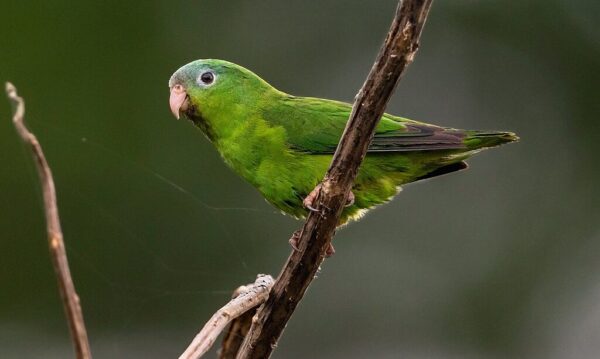Amazonian Parrotlet
Also known as:
Manu Parrotlet
Also known as:
Manu Parrotlet

Nannopsittaca

dachilleae
Size:
12 cm (4.68in)
Weight:
38-46 g.
Subspecies including nominate:
one
Colour Adult:
Both adults mainly yellow/green in colour; light blue lores, forehead and forecrown; yellow/green cheeks and chin; olive wash to mantle and lesser wing coverts. Beak pale pink. Eye brown.
Colour Juvenile:
Not recorded.
Call:
Calls are described as high-pitched and piping, sounding very like domestic fowl chicks.
Content Sources:
CITES
BirdLife International
Cornell Lab of Ornithology/Birds of the World
A Guide to Parrots of the World, Juniper and Parr, 1998.
Parrots of the World, Forshaw, 2006. 2010 edition
Captive Status:
Not found in aviculture.
Longevity:
—
Housing:
—
Diet:
—
Enrichment:
—
Nest Box Size:
—
Clutch Size:
Not recorded.
Fledging Age:
—
Hatch Weight:
—
Peak Weight:
—
Weaning Weight:
—
World Population:
2500-10,000 mature individuals, decreasing. From very common to patchily distributed and very uncommon.
IUCN Red List Status:
Least Concern
CITES Listing:
Appendix II
Threat Summary:
Not globally threatened. Common to abundant in some localities and very uncommon in others. The species’ habitat is threatened by oil exploration, mining and logging. Given the species’ apparent restriction to riparian and relatively open forests, rates of population decline may be exacerbated by additional effects of forest degradation.
Range:
Western Amazon River basin, where recorded in E Peru from Iquitos district, Loreto, drainages of Rio Ucayali, Ucayali and Rio Manu, Madre de Dios, and along Rio Heath, La Paz, NW Bolivia.
Habitat:
Found up to 300 m (984 ft) in lowland forest near rivers and streams, Calocophyllum and Cecropia sp. treed areas, and bamboo groves.
Wild Diet:
Feeds on fruits and also Cecropia catkins, fruits or seeds of an arboreal epiphytic cactus Rhipsalis, Vernonia and Guadua bamboo seeds, and ripe fruits of Coussapoa vine.
Ecology and Behaviour:
Social and active; forms flocks of up to 12 individuals. Frequents mineral-rich river banks with other parrots.
Clutch and Egg Size:
Not recorded.
Breeding Season:
Possibly July-September; one nest cavity recorded in epiphyte clump.
Related Links:
—

